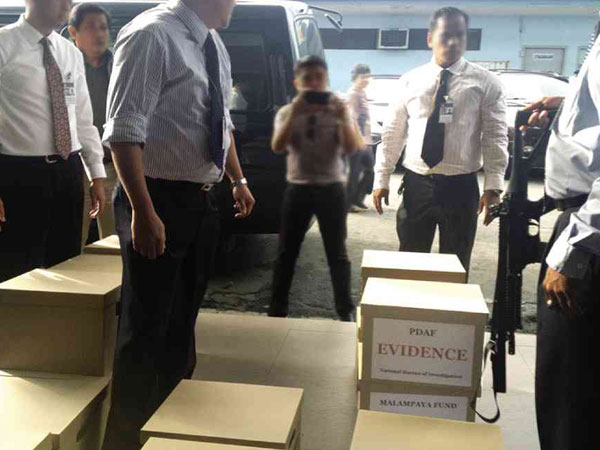Comes now the Philippine Daily Inquirer report of the transmittal of 15 boxes of documents (some 2,000 pages it said) to the National Bureau of Investigation (NBI).

Inquirer photo and report: On Wednesday afternoon, 15 boxes of evidence and more than 2,000 pages of financial transactions purportedly detailing the extent of a P10-billion racket involving state funds meant to ease rural poverty and ended in kickbacks over 10 years were submitted to the National Bureau of Investigation.
The evidence that could implicate the senators—principally endorsements of questionable nongovernment organizations (NGOs)—would come from official records, according to a source who is privy to the investigations.
“The smoking gun that could pin down the senators comes from government agencies where these letters were sent,” said the source who talked to the Inquirer on condition of anonymity.
I hesitate to use the word “evidence”, although the Inquirer report and photo clearly labels them as such. This is because, by my experience, the word has become so subjective that these materials being proof of an act – in this case a criminal act – only becomes established AFTER (not before) the court of law has sifted through it and decided it so.
There are so many levels by which evidence is judged, and while the rules of evidence in courts of law are very clear (and quite tedious, if I may say so myself), these materials by themselves may lead to wrong conclusions, malicious labeling or, worse, more dangerous movements like lynch mobs.
In the old martial law days and in the early Cory Aquino administration, Juan Ponce Enrile as then head of the military establishment used to use this old saying in his drive against the communist insurgency, its people and its front organizations: “If it walks like a duck, and quacks like a duck, the it IS A DUCK!”
Indeed, what more evidence do you need to arrest somebody in the streets, lock him up and throw away the key?
When I was an investigative reporter doing a series on the Coconut Levy scam and the United Coconut Planters Bank, my main documentary evidence was the report made by audit firm commissioned by the Presidential Commission on Good Government (PCGG). As I made the story I consulted with my assigned editor about the absence of the actual supporting documents like receipts and vouchers even though they were mentioned in the auditor’s report. My editor’s reply: “Always remember, the rules of evidence in journalism are different from the courts’.”
And what about the so-called “second envelope” that was bandied about at the Erap impeachment trial in the Senate? It was unopened, and nobody knew what the hell was inside it? But it moved many in Metro Manila to clog a main thoroughfare – EDSA Dos – and oust a constitutionally elected president.
I’m no lawyer, but I’ve covered enough cases as a journalist to know that in a court of law you can’t just present a piece of paper or any material and call it evidence. It must be supported, corroborated and attested to by other witnesses, evidence, experts.
For example, if a news video on TV shows me clearly pointing a gun and shooting somebody on the head, it doesn’t mean that it is enough to convict me in court for murder. That video clip first must be attested to by the people who took it, reported on it and broadcast it – the cameraman, editor, reporter and broadcast network. It must match the raw footage from where it came from which is again attested to the same people. They all must be attested to by recognized independent technical experts who will say that the video – both clip and raw – are real and untouched. And the events contained within the videos must be corroborated by other credible witnesses in the area, seeing the same thing.
At any time my defense could throw a monkey wrench on the case of my prosecutors: the videos may be manufactured and a product of CG technology; it could have been taken out of context because the raw footage would show that I was defending myself or saving a damsel in distress; the guy in the footage was just my look alike and I was actually sleeping in my home… remember, the finding of guilt must be beyond reasonable doubt. The slightest doubt should mean acquittal.
That’s why you have statements like what Senator Jinggoy Estrada’s where he laments that he is being “condemned without trial” (http://www.journal.com.ph/index.php/news/national/57948-condemned-without-trial–jinggoy) and Senate President Franklin Drilon complaining that he is being pronounced “guilty by association” for his party photos with Janet Lim Napoles.
Whistleblower Ben Hur Luy and his lawyer Levito Baligod are having a field day with all the attention and adoration, if only to condition the public that all these mountains of “evidence” are there for the world to see so the people they say are guilty MUST be found guilty. And it doesn’t hurt that they have reporters and publications that are lining up to take down and dish out what they say even before the courts have a chance to sift through the chaff and grain, if only to get more attention and sell more airtime, newsprint, shampoo sachets and prepaid cards.

Pingback: Perception, Not Justice | JPFenix Blog